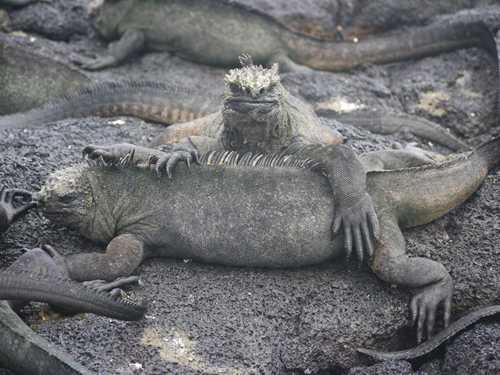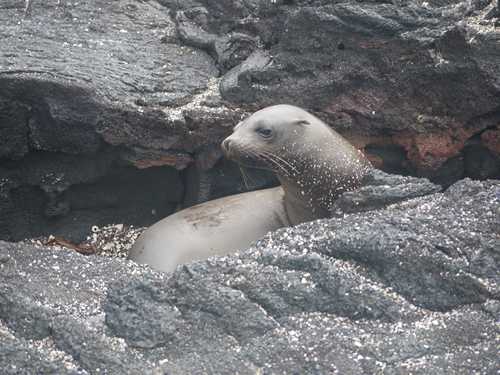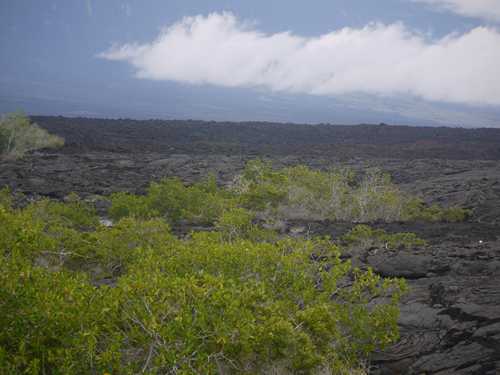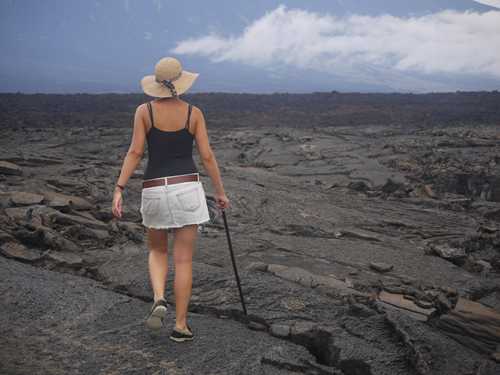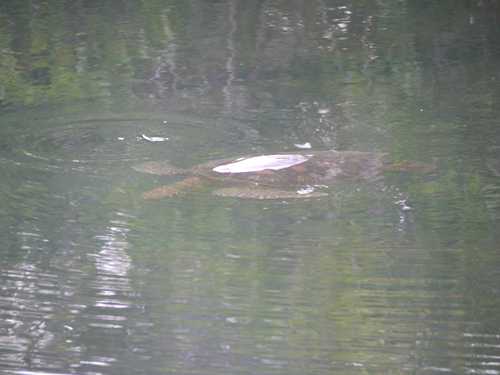Galapagos Cruise - Day 3

|
Friday 19th March
During the night between the second and third day we motored about 7 hours to Espinosa Point on Isla Fernandina. It was another early start and this time it was to be a two and a half hour hike! When we stepped off the dinghy on to the rocks we were immmediately hit with a strong smell. It was a mixture of the sea lions and the marine iguanas - the worst possible combination! A couple of steps from the rocks and we stumbled across a colony of approximately 100 marine iguanas so we had to pretty much walk in amongst them to get to the other side.
We were impressed at that but it was only the start as over the next couple of hours we saw colony after colony of marine iguanas and each colony seemed to grow in size. The guide told us that on the island there will be over 3000 within a square mile! You'd be walking along and suddenly see one as you were about to step on it (they just don't move away from you) then you'd look up and realise there are hundreds in front of you. They're so difficult to see as they blend in to the lava rock, and they're very strange pre-historic looking creatures, not the prettiest!
We also saw the flightless cormorants nesting sites. The flightless cormorant is the only cormorant found in the islands. They are aptly named owing to its complete inability to fly, it's wings appear to serve no useful purpose. One theory is that evolution is happening right in front of our eyes because the birds used to have wings enabling them to fly but since being on the islands their wings have decreased in size and they have lost the chest bone that enabled them to fly. The reason for this is believed to be because they no longer had a need to fly and search for food as everything they needed was at the islands as they have the ability to dive down to 74 feet. Another theory is that when the eggs were laid on the lava the heat caused something to happen to the egg leading to a deformed cormorant. However, this isn't really supported as other animals laid eggs onto the hot lava and no change has been seen with them. Non the less they are very interesting animals and they have beautiful bright turquoise eyes.
There were lots of sea lions and lots of pups, unfortunately including a dead one. The Galapagos Sea Lion is the largest animal found on land in the islands. While the population is estimated to be around 50,000 this can be severely reduced by a major El Nino event which seriously affects their food supply, and this year there has been an El Nino. The species also suffers from a virus known as sea lion pox, which is thought to be transmitted by mosquitos. The mosquitos transmit the disease by biting them on any cuts and sores that they have got. We were pre warned about finding dead sea lion pups and they were the reasons given for the deaths, and of course there is also the possibility that the mother could have been killed whilst fishing at sea.
The most recent eruption happened in May 2005 causing the sea level to raise approximately 5 metres. When this happened a whale skeleton was discovered as well as a huge engine thought to be from an old fishing vessel. We thought the whale skeleton was rather large but it was actually only from a juvenile!
We then hiked all over the lava formations to tide pools where we were hunting for turtles, sharks and rays. The scenery was very impressive.
Lava Cacti
The pool where we hunted for wildlife and spotted a few turtles (one to the right).
Paul with his mate to the left. Whilst waiting for
the dinghy to come and pick us up we spotted a Galapagos shark which was about 3
metres long. Apparently the Galapagos shark is one of the most dangerous,
something we didn't realise but something we're glad we know now! We then motored a short distance over to Tagus Cove on Isla Isabela, the largest island in the archipelago at 4588 sq km. The island consists of a chain of five fairly young and intermittently active volcanoes, including the Darwin volcano. Early sailors who frequently anchored in Tagus Cove scratched the names of their vessels into the cliffs around the coves. It's a strange sight to behold graffiti, the earliest from 1836, in an otherwise pristine environment. On the way to Tagus Cove we saw a killer whale making a kill. The Captain was following him wherever he went and we witnessed the whole thing - another great experience to add to the list!
Once again it was raining and we were off snorkelling but once you're in the water you can't tell the difference, although the visibility does decrease slightly. Anyway, Paul swam off alone ahead of the group, Amy and Jack buddied up and I held back with Amanda and we all had completely different experiences. Paul saw turtle after turtle after turtle and that was about it. Amy and Jack saw lots of turtles just not as close up, a huge puffa fish, they were swimming with sea lions again and best of all a penguin! He was eating the algae floating in the water around them so he kept zipping inbetween them for some time. And me and Amanda just saw one turtle very close up.
The Galapagos Penguin is one of the smallest penguins in the world; it's some 50cm in length but only 35 cm tall when standing. It is the only penguin to breed entirely within the tropics, and the only one to be found in the northern hemisphere.
Almost as soon as we were back on board it was time to disembark again for hike up the Darwin volcano. The trail leads up 130 steps to Darwin's saltwater lagoon providing excellent views of the bay, the lagoon and the lava formations. As it was torrential rain we were asked if we wanted to continue but what else were we going to do, we'd just end up sitting on the boat playing on the wii. So we continued on the trail to the lower lava slopes of the volcano. We were promised that had it non have been raining there would be stunning views of the volcanic formations and lava slopes. It was great fun though and we did stumble across a wild giant tortoise on the path on the way up so we can't complain really. We then had a dinghy ride along the cliffs to see the historical graffiti and we also saw some more penguins and cormorants. A very good day!
|








